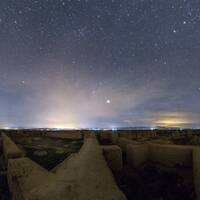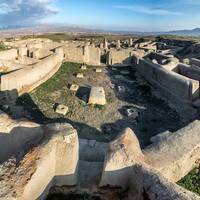A mound is different from a typical hill. Different layers from different historical eras are formed on top of each other in time and as years go by, each is replaced by layers from new civilizations. Hasanlu mound, also known as Teppe Hasanlu, is one of the historical sites of Iran that has contained in itself some unique artifacts such as Golden bowl of Hasanlu. Located about twenty meters higher than sea level, Teppe Hasanlu is the remainder of an ancient civilization on a hill with about two hundred and sixty-five meters diameter.
The oldest humans are known to inhabit Hasanlu mound are the Mannai tribe. The bronze products of Mannai tribe are comparable with famous bronze pieces of Lorestan. The specialists have identified ten layers of different periods in Hasanlu, amongst which the oldest date back to six thousand years B.C. The ninth and seventh periods are dated between six thousand and three thousand years B.C.
The early archeological researches in Teppe Hasanlu were conducted in 1934. Two years later, in 1936, Sir Aurel Stein, the English scientist, conducted multiple surveys, which resulted in the discovery of some artifacts. Two other expeditions were carried out in 1947 and 1949 respectively. Eventually, a scientific excavation began by the Chief Archeological Office in 1949. It should be mentioned that the objects that are exhibited today in the National Museum of Iran were found during this survey. However, it was an excavation group of both Iranian and American archeologists who discovered the Golden bowl of Hasanlu in 1957.
Golden bowl of Hasanlu is considered one of the most celebrated national artifacts of Iran. It was found during the researches of Robert Dyson from America in 1958 in Teppe Hasanlu. The age of this bowl has been estimated to be about three thousand and two hundred years. Images have been engraved on its body that seems to depict an epic story. The bowl is now kept at the National Museum of Iran next to other discoveries of this site.
Teppe Hasanlu is located seven kilometers away from the Naqadeh County in West Azerbaijan. It is considered a historical site that is only twelve kilometers from Lake Urmia and between two villages of Aminlu and Hasanlu, which is the reason it has been named so.


